Amphimoea walkeri
|
|
Updated as per
AN ANNOTATED CHECKLIST OF THE SPHINGIDAE OF BOLIVIA, October 2007
Updated as per More, Kitching and Cocucci's Hawkmoths of Argentina 2005, October, 2007
Updated as per personal communication with Jose Monzon (Guatemala); May 2009
Updated as per Sphingidae (Lepidoptera) de Venezuela, Compilado por: María Esperanza Chacín; December 2009
Updated as per personal communication with Humberto Calero Mejia (PNNG, Isla Gorgona, Cauca, Colombia, June 1, 2011); October 12, 2011
Updated as per personal communication with Hubert Mayer (Quebrado Pelejo, Huallago, San Martin, Peru, July, 2006); June 3, 2014
Updated as per personal communication with Ezequiel Bustos (Shilap revta. lepid. 43 (172) diciembre, 2015, 615-631 eISSN 2340-4078 ISSN 0300-5267), January 4, 2016
Updated as per personal communication with Anna and Frank West (Morales, Izabal, Guatemala), January 16, 2021
|
Amphimoea walkeri
am-fih-MEE-aM WAHL-ker-eye
The Darwin Hawkmoth
(Boisduval, [1875]), Amphonyx
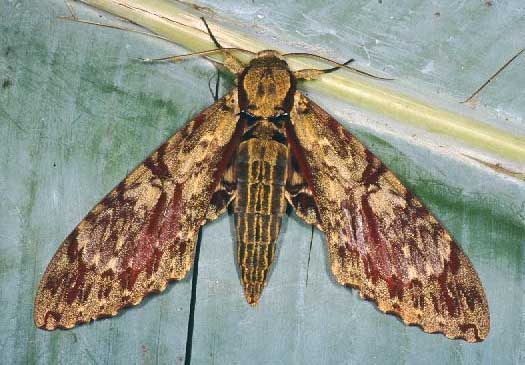
Amphimoea walkeri from Rancho Grande, H. Pittier National
Park, Venezuela
courtesy of Paolo Mazzei.
This site has been created by Bill Oehlke.
Comments, suggestions and/or additional information are welcomed by Bill.
TAXONOMY:
Family: Sphingidae, Latreille, 1802
Subfamily: Sphinginae, Latreille, [1802]
Tribe: Sphingini, Latreille, 1802
Genus: Amphimoea Rothschild & Jordan, 1903 ...........
Species: walkeri (Boisduval, [1875])
|
DISTRIBUTION:
The Darwin hawkmoth, Amphimoea walkeri,
Wingspan: 147-164-180mm, females larger than males], flies in
Mexico;
Belize: Toledo;
Guatemala: Izabal (JM; AFW);
Nicaragua: Chontales, Rio San Juan;
Costa Rica: Lemon, Heredia, Puntarenas,
Alajuela, Guanacaste, San Jose, Carthage;
to Brazil: Para: Parauapebas; and
Colombia: Isla, Gorgona; June 1, 2011 (HCM; 180mm+);
Peru: San Martin (HM);
Venezuela: Amazonas, Aragua, Carabobo, Miranda;
Suriname BOLD;
French Guiana BOLD
Bolivia: Santa Cruz: Ichilo, La Víbora;
Argentina: Misiones.
I would not be surprised if it also flies in
southeastern Paraguay: (Itapua (WO??)).
Guyana is the specimen type locality.
Robert Lehman confirms it in Honduras: Atlantida.
Amphonyx staudingeri Druce, 1888, Panama, is the same as walkeri.
Cocytius magnificus Rothschild, 1904, Guyana, is the same as walkeri.
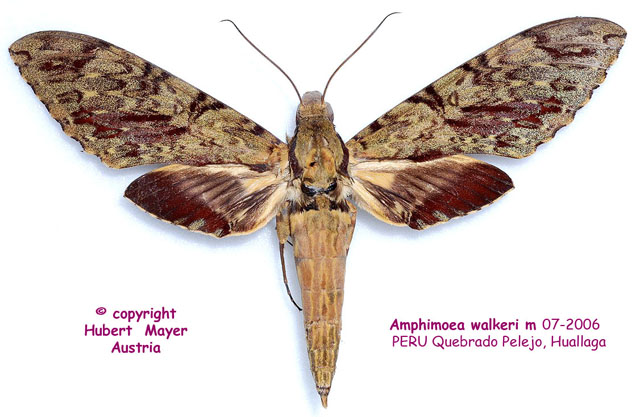
Amphimoea walkeri male, Quebrado Pelejo, Huallaga, San Martin, Peru,
152mm, July 2006, courtesy of Hubert Mayer copyright.
FLIGHT TIMES:
Amphimoea walkeri adults fly in all months except March in Costa Rica.
In Bolivia they have been
recorded in March and June and possibly fly in other months as well. Humberto Calero Mejia reports an early June flight on Isla Gorgona, Cauca, Colombia.
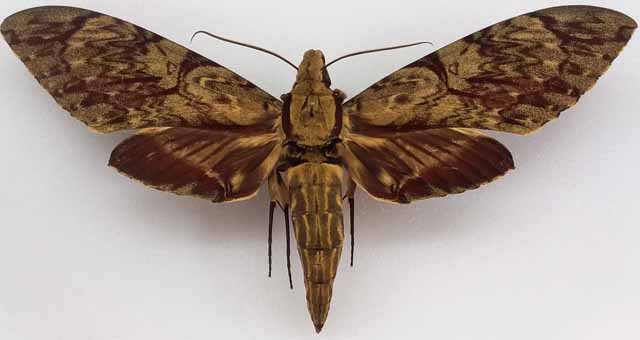
Amphimoea walkeri 160mm, Guatemala: Izabal: near Morales,
July 8, 2005, 2100ft., courtesy of Anna and Frank West.
Adults have the longest insect proboscis (over ten inches long) in the world and nectar from
deep-throated flowers while hovering in the air. | 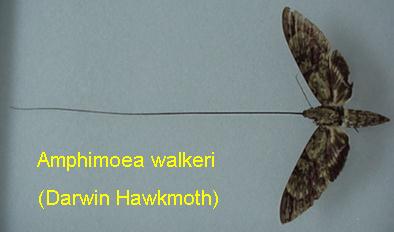 |
ECLOSION:
Pupae probably wiggle to surface from subterranean chambers just prior to eclosion.
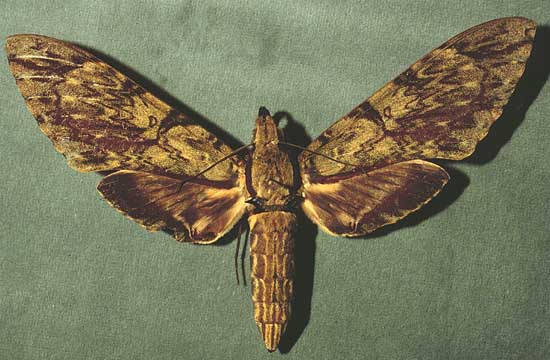
Amphimoea walkeri female courtesy of Dan Janzen.
Note shadow of coiled proboscis.
SCENTING AND MATING:
Females call in the males with a pheromone released from a gland at the tip of the
abdomen.
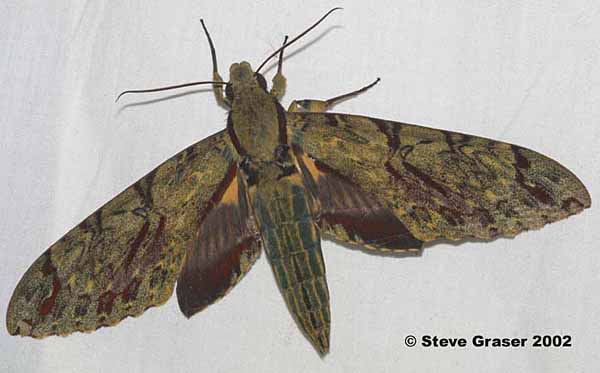
Amphimoea walkeri
courtesy of Steve Graser,
Yasuni, Ecuador, September 10, 2002 - 11:58 PM.
EGGS, LARVAE, PUPAE:
Larvae feed on
Anaxagorea crassipetala, a lowland rain
forest tree of Costa Rica and surrounding areas, and probably other
members of the Annonaceae family. Photo by G. Gentry.
| 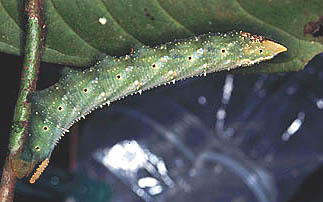 |
Please send sightings/images to Bill. I will do my best to respond to requests for identification help.
Return to U. S.A. Table
Return to Sphingidae Index
Return to Sphingini Tribe
Goto to Indices by Nation
Use your browser "Back" button to return to the previous page.
This site has been created by Bill Oehlke.
Comments, suggestions and/or additional information are welcomed by Bill.
Enjoy one of nature's wonderments: Live Saturniidae (Giant Silkmoth) cocoons.
 | 
Show appreciation for this site by clicking on flashing butterfly to the left.
The link will take you to a page with links to many insect sites. |
This website has been created and is maintained by Bill Oehlke without government or institutional financial assistance. All expenses, ie., text reference
support material, webspace rental from Bizland, computer repairs/replacements, backups systems, software for image adjustments (Adobe Photoshop; L-View),
ftp software, anti-virus protection, scanner, etc. are my own.
I very much appreciate all the many images that have been sent to me, or of which I have been granted permission to copy and post from other websites.
All images on this site remain the property of respective photographers.
If you would like to contribute to the maintenance of this website by sending a contribution to
Bill Oehlke
Box 476
155 Peardon Road
Montague, Prince Edward Island, C0A1R0
Canada
Your donation would be much appreciated and would be used for
1) paying for webspace rental;
2) paying for computer maintenance and software upgrades;
3) purchases of additional text reference material (journals and books) in an effort to stay current with new species;
4) helping to pay my daughter's tuition (completed spring 2013).
I also hope to expand the North American Catocala site as well as the Sphingidae of the Americas site, to worldwide sites, and that
will require additional funds for reference materials, etc. Both of those site are linked from your WLSS homepage.
If you are mailing a check from USA, please use $0.85 postage ($1.25 is 2017 rate, check first with post office as rates seem to increase annually).
Donations can also be made through Paypal via the button below.
Donations are not required to maintain your standing as a WLSS member, nor do they gain you any preferencial treatment with regard to livestock and/or
supplies (sleeves), compared to other WLSS members. All WLSS members get first crack at my annual offerings and get an approximate discount of 10% as
compared to non-members.
I do usually ask donors if they have any special requests for material on WLSS, and I try to accomodate when appropriate or within my ability to do so.








